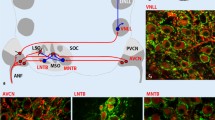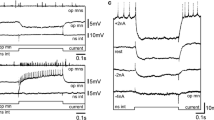Abstract
THE rate of secretion of a transmitter substance from a nerve terminal is known to be controlled by the membrane potential of the terminal. This has been shown, for example, at the neuromuscular junction by registering the frequency of miniature end-plate potentials when electric currents are sent through the motor nerve endings1. More recently, the use of tetrodotoxin2 has made it possible to eliminate initiation of impulses on either side of the junction, and so to study the graded relation between electrical “input” and “output” of a synapse, undisturbed by any regenerative potential change. With this method it has been found that brief pulses of depolarization, locally imposed on a motor nerve ending, elicit graded end-plate potentials the size of which can reach or even surpass that normally produced by a nerve impulse3. To obtain additional information, it was necessary to use a preparation in which direct measurements of the membrane potential can be made on both sides of the junction. The so-called giant synapse of the squid4 is suitable for this purpose: it is possible to insert microelectrodes in the pre- as well as post-synaptic nerve fibres of this preparation, close to their region of synaptic contact, and there is now good evidence that chemical transmission operates at this synapse5. The experiments reported here were made on the stellate ganglion of the squid Loligo vulgaris at the Naples Zoological Station. Similar work carried out at Woods Hole has been reported by Bloedel, Gage, Llinás and Quastel6.
Similar content being viewed by others
References
del Castillo, J., and Katz, B., J. Physiol., 124, 586 (1954); Liley, A. W., J. Physiol., 134, 427 (1956); Katz, B., and Miledi, R., Proc. Roy. Soc., B, 161, 453 (1965).
Narahashi, T., Moore, J. W., and Scott, W. R., J. Gen. Physiol., 47, 965 (1964).
Katz, B., and Miledi, R., Nature, 207, 1097 (1965); J. Physiol., 185, 5P (1966); Proc. Roy. Soc., B (in the press).
Young, J. Z., Phil. Trans. Roy. Soc., B, 229, 465 (1939).
Hagiwara, S., and Tasaki, I., J. Physiol., 143, 114 (1958). Takeuchi, A., and Takeuchi, N., J. Gen. Physiol., 45, 1181 (1962); Miledi, R., and Slater, C. R., J. Physiol., 184, 473 (1966).
Bloedel, J., Gage, P. W., Llinás, R., and Quastel, D. M. J., Nature, 212, 49 (1966).
Miledi, R., Nature (preceding communication).
Katz, B., Proc. Roy. Soc., B, 155, 455 (1962).
Nakamura, Y., Nakajima, S., and Grundfest, H., J. Gen. Physiol., 48, 985 (1965).
Armstrong, C. M., and Binstock, L., J. Gen. Physiol., 48, 859 (1965). Armstrong, C. M., Nature, 211, 322 (1966).
Katz, B., and Miledi, R., Proc. Roy. Soc., B (in the press).
Miledi, R., and Slater, C. R., J. Physiol., 184, 473 (1966); Katz, B., and Miledi, R., Proc. Roy. Soc., B, 161, 496 (1965).
Hagiwara, S., and Tasaki, I., J. Physiol., 143, 114 (1958).
Katz, B., and Miledi, R., Proc. Roy. Soc., B, 161, 453 (1965). Braun, M., and Schmidt, R. F., Pflügers Arch., 287, 56 (1966); Miledi, R., and Slater, C. R., J. Physiol., 184, 473 (1966).
Author information
Authors and Affiliations
Rights and permissions
About this article
Cite this article
KATZ, B., MILEDI, R. Input–Output Relation of a Single Synapse. Nature 212, 1242–1245 (1966). https://doi.org/10.1038/2121242a0
Received:
Published:
Issue Date:
DOI: https://doi.org/10.1038/2121242a0
- Springer Nature Limited
This article is cited by
-
Presynaptic K+ Channels, Vesicular Ca2+/H+ Antiport—Synaptotagmin, and Acetylcholinesterase, Three Mechanisms Cutting Short the Cholinergic Signal at Neuromuscular and Nerve–Electroplaque Junctions
Journal of Molecular Neuroscience (2014)
-
Synaptic plasticity in cephalopods; more than just learning and memory?
Invertebrate Neuroscience (2013)
-
Ricardo Miledi and the calcium hypothesis of neurotransmitter release
Nature Reviews Neuroscience (2002)
-
Reduction of the voltage-dependent calcium current inAplysia neurons by pentobarbital
Cellular and Molecular Neurobiology (1986)
-
Calcium ion fluxes across the external surface ofPhysarum polycephalum
Protoplasma (1977)





